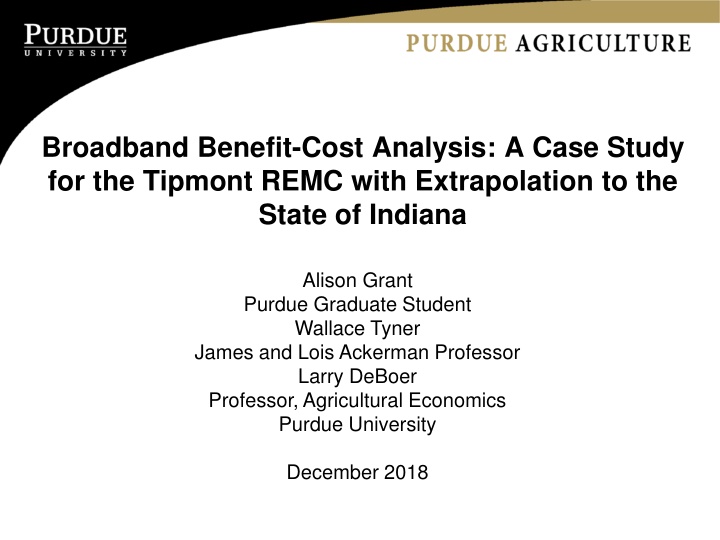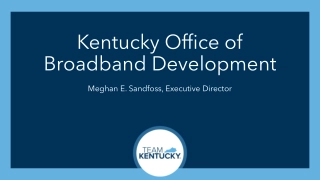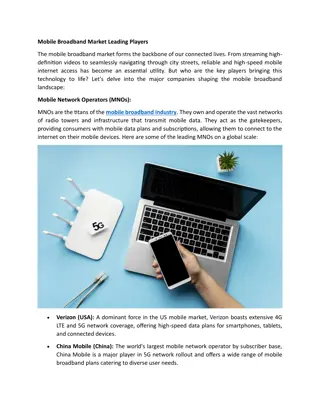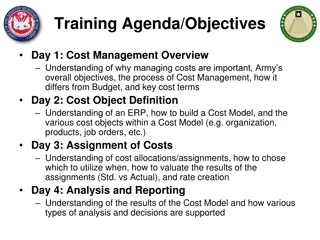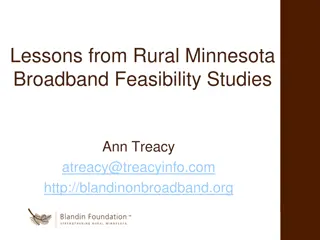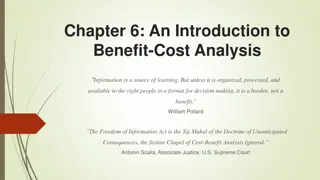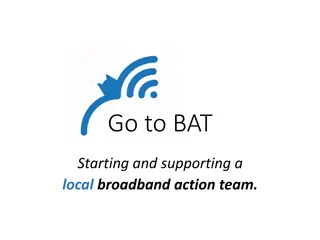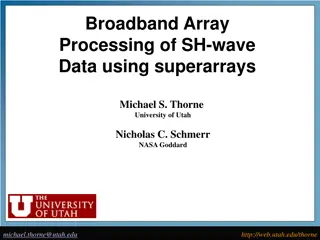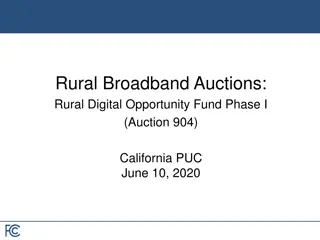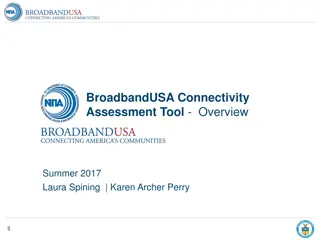Rural Broadband Benefit-Cost Analysis Case Study
Economic impact of rural broadband analyzed through a benefit-cost analysis for Tipmont REMC, with extrapolation to Indiana state. Significant net benefits projected with potential tax revenues and health care savings. Study approach included estimation of benefits by category and conservative assumptions.
Download Presentation

Please find below an Image/Link to download the presentation.
The content on the website is provided AS IS for your information and personal use only. It may not be sold, licensed, or shared on other websites without obtaining consent from the author.If you encounter any issues during the download, it is possible that the publisher has removed the file from their server.
You are allowed to download the files provided on this website for personal or commercial use, subject to the condition that they are used lawfully. All files are the property of their respective owners.
The content on the website is provided AS IS for your information and personal use only. It may not be sold, licensed, or shared on other websites without obtaining consent from the author.
E N D
Presentation Transcript
Broadband Benefit-Cost Analysis: A Case Study for the Tipmont REMC with Extrapolation to the State of Indiana Alison Grant Purdue Graduate Student Wallace Tyner James and Lois Ackerman Professor Larry DeBoer Professor, Agricultural Economics Purdue University December 2018
Data Fuel for the Future Data are to this century what oil was to the last one: a driver of growth and change. Flows of data have created new infrastructure, new businesses, new monopolies, new politics and crucially new economics. Digital information is unlike any previous resource; it is extracted, refined, valued, bought and sold in different ways. It changes the rules for markets and it demands new approaches from regulators. The Economist
Rural Broadband In the long run, the economic impact of rural broadband will be more important for the role it plays in changing what the economy is. Information technology shows an amazing capability to create new services. It has also disrupted the role that location plays in the economy. Broadband networks have nearly erased the cost of moving information. Broadband networks allow that disruptive role to happen. This disruption will reach as far as the broadband speed required to support these uses will allow. - Kuttner
Overview of Todays Presentation 1. Present value of total benefits and costs by category for the Tipmont Case Study 2. Other metrics 1. Benefit cost ratio 2. NPV benefit per member 3. Annualized benefit per member 4. Benefit per $1 expended by customers 3. Review the extrapolation of broadband benefits to the State of Indiana 4. Tax and govt. expenditure impact calculations
Summary of Results The benefit/cost ratio is around 4 Statewide, the net benefits (NB) amount to about $1 billion/year Federal and state governments would have increased tax receipts and lower Medicare and Medicaid costs. Government tax revenues and health care cost savings amount to about of total NB
Study Approach We estimated rural broadband benefits by category (type of benefit) Where possible, we used sources from the literature to estimate category benefits When literature sources were not available, we made conservative assumptions on benefit magnitudes. System cost information came from Tipmont
Other Assumptions We used a 6% discount rate for future benefits and costs We used a 20 year project period, but clearly benefits would continue beyond that period. The take rate was taken from analysis done by Prof. Nicole Widmar
Benefit Categories Telemedicine Education (K-12 & Adult) Consumer savings Farm income increases Multiplier benefits
Benefit Cost Summary for the Different Benefit Categories Item Capital cost Operating cost Total cost Telemedicine Primary care savings Specialist Transport Missed Work Pharmacy Imaging Web consultation Urgent care Emergency care Total telemedicine K-12 education Adult education Multiplier impacts Consumer savings Farm income increase System revenue Total Benefit Net benefits Net present values 99,804,558 89,613,882 189,418,440 22,977,791 28,633,511 671,568 7,961,549 20,992,056 4,255,146 5,106,176 21,701,247 110,986,276 223,285,320 18,981,795 103,672,388 187,524,256 106,946,014 7,165,348 102,123,515 749,698,635 560,280,195
Benefit Categories by Share of Total Benefits Farm income increase 1% System revenue 14% Telemedicine 30% Consumer savings 14% Multiplier impacts 25% Adult education 14% K-12 education 2%
Tipmont Result Summary NPV benefit per member: $24,757 Net benefit per member per year: $2,158 Benefit-cost ratio: 3.96 Every $1 invested in broadband returns $4 to the local economy Every dollar expended by customers returns $4.5 In terms of extrapolating to the state: we use the benefit per co-op member for all other state co-ops
Telemedicine Overview of Benefit Categories: 1. Hospital Cost Savings from Outsourcing Procedures 2. Lab/Pharmacy Work Performed Locally 3. Reduced Use of Emergency Departments, Overnight Stays, Ambulance Services, Number of Referrals, etc. 4. Initial Health Consultation via Web 5. Transportation Savings 6. Missed Work Income PROVIDER SIDE PATIENT SIDE
TOTAL Value of telemedicine $20.5 million in year 3 $223 million NPV over 20 years
Education K-12 Increases the number of learning environments Enhances educational opportunities for disabled students More interactive and personalized instruction Enhances learning outcomes Promotes the development of 21st century skills
Education K-12 Benefit Estimation included proxy of the value of improvement in teacher productivity We know that teachers provide value greater than their cost Used teacher salaries as a basis for a productivity increase Benefit Estimation: $1,538,383 in year 3
Education K-12 The Tippecanoe County Schools expenditure for teacher salary and benefits for 2016-17 was $50,987,789. Given all the literature on better learning outcomes, efficiencies, etc. from the literature, we assumed that there would be a 5% gain in productivity (for half), which is scaled by the number of connecting households.
Education - Adult The Tipmont customer median household income is $73,092. We assume that 1 in 4 of those households would have a new or better job valued at 5% of household income This benefit calculation is scaled to connected households each year Benefit Estimation: $9,594,041 in year 3
General Economic Development Household income growth, business investment, and consumer savings Previous work had suggested a household income gain independent of other categories. However, we decided to assume in is included in the adult education and multiplier categories.
Multiplier Benefits When an investment is made, the spending associated with that investment provides benefits to those who receive the spending and to others in the community. We used two sources of multiplier values of 1.99 and 1.3264, and also 0.99 thereby excluding the system costs. Multiplier NPV ranged from $188 million (base case) to $376 million NPV.
Consumer Savings Consumers potentially save in purchases of household items, insurance, energy, services, etc. A UK study by Price Waterhouse Coopers estimated household savings of $754/household/year Benefit Estimation: $ 9,896,989 in year 3
Farm Income Increases The literature indicates farm sales and expenses grow due to broadband access (encompasses access to information, technology such as GIS and scouting drones, precision ag, etc.) Tippecanoe County crop sales in 2012 were $132,619,000 and we assumed a 1% increase due to broadband and applied it to 50% of sales. We also used a lower bound of $500 per connected member. Benefit Estimation: $663,095 in year 3
Civic Engagement We found two important studies on the impacts of broadband on civic engagement and voluntary activity The qualitative descriptions of benefits were significant We could not quantify this benefit This is a probable benefit that has been left out in our calculations
Investment Costs Capital Cost Distribution Fiber Core Network Substation Electronics* Drop Installation* Subscriber Electronics* Total Build Capital Cost *Based on 100% take rate Amount ($) 86,080,296 1,625,000 4,561,405 12,359,200 12,675,600 117,301,501 105,792,832 Adjusted Amount 86,080,296 1,625,000 2,787,674 7,553,248 7,746,614
Operating Costs year Fixed Labor Subscribers Revenue Tax New Sub. Billing Churn Bad debt Marketing Access Fee Total 1 868,549 1,098,750 3281 2,362,676 33,077 39,378 25,596 26,252 23,627 778,930 617,479 3,511,638 2 1,155,455 1,841,250 8532 6,142,959 86,001 63,005 66,549 68,255 61,430 565,775 2,119,491 6,027,211 3 1,190,205 2,016,250 13126 9,450,706 132,310 55,129 102,383 105,008 94,507 339,465 3,501,093 7,536,349 4 1,165,070 2,122,500 13224 9,521,586 133,302 1,181 103,151 105,795 95,216 228,007 4,286,962 8,241,184 5 1,210,562 2,242,500 13324 9,592,998 134,302 1,190 103,924 106,589 95,930 229,717 4,294,199 8,418,913 6 1,189,115 2,242,500 13424 9,664,945 135,309 1,199 104,704 107,388 96,649 173,580 4,301,438 8,351,882 7 1,193,269 2,242,500 13524 9,737,432 136,324 1,208 105,489 108,194 97,374 174,882 4,295,966 8,355,206 8 1,229,197 2,325,000 13626 9,810,463 137,346 1,217 106,280 109,005 98,105 176,194 4,279,951 8,462,295 9 1,218,898 2,325,000 13728 9,884,042 138,377 1,226 107,077 109,823 98,840 177,515 4,268,396 8,445,152 10 1,210,249 2,325,000 13831 9,958,172 139,414 1,236 107,880 110,646 99,582 178,846 4,363,477 8,536,331 11 1,213,815 2,325,000 13831 9,958,172 139,414 0 107,880 110,646 99,582 178,846 4,397,778 8,572,962 12 1,215,738 2,325,000 13831 9,958,172 139,414 0 107,880 110,646 99,582 178,846 4,411,608 8,588,716 13 1,219,444 2,325,000 13831 9,958,172 139,414 0 107,880 110,646 99,582 178,846 4,398,193 8,579,006 14 1,223,222 2,325,000 13831 9,958,172 139,414 0 107,880 110,646 99,582 178,846 4,368,733 8,553,324 15 1,227,073 2,325,000 13831 9,958,172 139,414 0 107,880 110,646 99,582 178,846 4,373,574 8,562,016 16 1,232,890 2,325,000 13831 9,958,172 139,414 0 107,880 110,646 99,582 178,846 4,362,786 8,557,044 17 1,236,892 2,325,000 13831 9,958,172 139,414 0 107,880 110,646 99,582 178,846 4,348,125 8,546,387 18 1,246,370 2,325,000 13831 9,958,172 139,414 0 107,880 110,646 99,582 178,846 4,395,150 8,602,889 19 1,248,030 2,325,000 13831 9,958,172 139,414 0 107,880 110,646 99,582 178,846 4,430,695 8,640,094 20 1,252,271 2,325,000 13831 9,958,172 139,414 0 107,880 110,646 99,582 178,846 4,435,536 8,649,176 NPV 13,527,498 24,485,885 141,838 102,123,515 1,429,729 145,164 1,106,338 1,134,706 1,021,235 3,164,847 43,598,480 89,613,882
Recap Total NPV over 20 years: $560 million NPV benefit per member: $24,757* Annualized benefit per member per year: $2,158 Benefit-cost ratio: 3.96 Every $1 invested in broadband returns $4 to the local economy NPV revenue/NPV cost = 0.54 *Over a 20-year time horizon
Extrapolation to the State Used an approach similar to that used for Tipmont to estimate benefits and costs for 6 additional Indiana cooperatives. Then, based on the more detailed results for the 7 cooperatives, we extrapolated results to all coops in the State
State Extrapolation NPV per member for the 7 cooperatives is $24,293. There are 400,263 cooperative members in Indiana not included in the 7. The extrapolated Statewide NPV benefits are $11,976,222,899, or about $12 billion. Over 20 years at 6%, that translates to $1.0 billion per year.
Metrics for other REMCs NPV /member B/member cost Rev/ cost 0.54 0.45 0.58 0.40 0.48 0.41 0.44 Cooperative Tipmont Henry County Jackson County Marshall County Noble County Orange County Whitewater NPV Ann. NPV 48,847,781 3.96 16,576,363 3.24 50,785,491 4.09 14,438,679 3.03 21,485,799 3.47 14,505,536 2.97 29,752,324 3.84 B/C Members 22,631 8,500 24,203 7,249 10,646 7,756 11,741 560,280,195 190,129,578 582,505,581 165,610,509 246,440,421 166,377,353 341,256,815 24,757 22,368 24,067 22,846 23,149 21,451 29,065 4.49 3.96 4.33 4.06 4.13 3.75 5.44
Federal and State Governments Rural residents would see added income and health care cost savings due to the expansion of rural broadband. Some of this added income would be paid in Federal income taxes, state income taxes and state sales taxes. Some of the health care cost savings would accrue to the Federal Medicare program, and the Federal and Indiana state Medicaid programs.
Federal and State Governments Estimation of revenues based only on the added incomes from adult education and the multiplier. These are the categories of benefits most likely to result in added taxable income. Estimation of telemedicine cost savings based on all savings categories except travel and lost work. The remaining categories are likely to be cost savings for government healthcare programs.
Federal Income Tax Use the average of the marginal and average tax rates, times the added income for each income level. Added Federal income tax revenue for all 7 cooperatives in Year 3 is $11.0 million. Revenue would be similar in all subsequent years.
Indiana State Income Tax The Federal IRS provides income tax data by county and zip code, including adjusted gross income, deductions and exemptions and other figures that allow estimation of Indiana taxable income, for each cooperative and income level. Indiana s marginal tax rate is 3.23%. With deductions and exemptions, the average rate is slightly less.
Indiana State Income Tax Use the average of the marginal and average tax rates, times the added income for each income level. Added Indiana state income tax revenue for all 7 cooperatives in Year 3 is $2.0 million. Revenue would be similar in all subsequent years.
Indiana State Sales Tax Statistical results combined with survey estimates of age and income for each cooperative produced estimated sales- taxable spending out of added income. These were multiplied by Indiana s sales tax rate, 7%. Added Indiana state sales tax revenue for all 7 cooperatives in Year 3 is $2.4 million. Revenue would be similar in all subsequent years.
Telemedicine Cost Savings Expanded broadband would allow rural households to reduce their health care costs. Health care costs are paid by households out-of- pocket, by private insurance companies, and by the Federal Medicare, and Federal and state Medicaid programs. Data from various sources are used to estimate the health care cost shares for each cooperative. For all cooperatives, 26% of costs are borne by Medicare, 17% by Federal Medicaid, and 4% by state Medicaid.
Telemedicine Cost Savings Federal Medicare cost savings for the 7 cooperatives would be $21.4 million in Year 3. Federal Medicaid cost savings for the 7 cooperatives would be $13.8 million in Year 3. State Medicaid cost savings for the 7 cooperatives would be $3.4 million in Year 3. Similar savings would occur in subsequent years.
Fewer Medicaid Recipients Added incomes imply that fewer people will be eligible for Medicaid. Statistical procedures are used to estimate the effect of added incomes on the number of Medicaid recipients in Indiana counties. Added income from rural broadband would reduce the number of Medicaid recipients by 2.2% in the 7 cooperatives. This results in added cost savings of $1.7 million for Federal Medicaid, and $0.4 million for Indiana Medicaid, in Year 3, with similar savings in subsequent years.
Total Federal and State Budget Impact For the 7 cooperatives in Year 3, total revenues and cost savings total $56.5 million. Federal revenues and cost savings total $47.9 million, and Indiana state revenues and costs savings total $8.6 million. This is 27% of Year 3 broadband net benefits, 23% Federal and 4% state. Similar revenues and savings would accrue each year.
Total Federal and State Budget Impact Federal and state revenues and cost savings are about one-quarter of total broadband benefits. Extrapolated to all cooperatives in the state of Indiana, these percentages imply added revenues and cost savings of $270 million per year, every year. Federal revenues and cost savings would be $230 million per year. State of Indiana revenues and cost savings would be $40 million per year.
1. Hospital Cost Savings from Outsourcing Procedures 2017 Indiana study estimates cost savings of telehealth of $162 per patient visit at primary care physician Assume 1 visit per household/year Benefit Estimation: $2,126,409 in year 3 Year 3 benefits are reported because that is the first year of full deployment.
1. Hospital Cost Savings from Outsourcing Procedures 158 specialists were found in three hospitals in the Tipmont service area Used median salary and (Whitacre, 2015) estimates of reducing specialist from 1.0 FTE to 0.2 FTE and assume of specialists would be impacted. Benefit Estimation: 2,496,400 in year 3
2. Lab/Pharmacy Work Performed Locally 2017 Indiana telehealth study: Cost savings of 12.56% for virtual lab rates vs. in-person cost savings of $148/lab service Benefit Estimation: $1,942,645 in year 3 Imaging rates cost savings of 6.62% per visit - $60 savings/visit Benefit Estimation: $393,779 in year 3
3. Reduced Use of Emergency Departments 2017 Indiana telehealth study: Cost savings of $1735 per patient visit at emergency departments, including ambulance services, overnight stays, and number of referrals From CDC survey: national average of 45.1 emergency department visits per 100 persons per year Benefit Estimation: $10,270,882 in year 3
*PATIENT SIDE* 4. Initial Health Consultation via Web 2017 Indiana telehealth study: Cost savings of $36 per patient visit at retail health clinics* Benefit Estimation: $472,535 in year 3 Cost savings of $153 per visit for urgent care clinics* Benefit Estimation: $2,008,275 in year 3 *numbers include medical and pharmacy costs
5. Transportation Savings to Center Patients Used average distance to three hospitals in Tipmont service area Average distance to hospitals and IRS mileage rate used to estimate the amount saved in foregoing travel Benefit Estimation: $62,148 in year 3
6. Missed Work Income Savings to Center Patients Used Tipmont data to determine median income of households in service area Estimated time to drive to hospitals + 1 hour appointment x average hourly wage rate = value of work hours saved Benefit Estimation: $736,777 in year 3
Capital Costs Capital costs differ among all the REMCs. Fiber distribution cost is a function of the miles of electric line in each coop Core network is a fixed cost. Costs for substation, drop installation, and subscriber electronics are a function of the number of members. The cost estimates for the other coops were done relative to the Tipmont values.
Capital Cost Illustration Capital Cost Distribution Fiber Core Network Substation Electronics* Drop Installation* Subscriber Electronics* Total Build Capital Cost Cost Basis 86,080,296 1,625,000 4,561,405 12,359,200 12,675,600 117,301,501 105,792,832 41,845,816 Tipmont Amount 86,080,296 33,427,038 1,625,000 2,787,674 7,553,248 7,746,614 Henry Amount 1,625,000 1,047,066 2,837,042 2,909,671 *Based on 100% take rate
Benefit Estimation The same procedures were used for the 6 additional coops as were used for Tipmont. The same benefit categories were used, but data for each coop was used to estimate benefits. The same approach also was used for operating costs.
